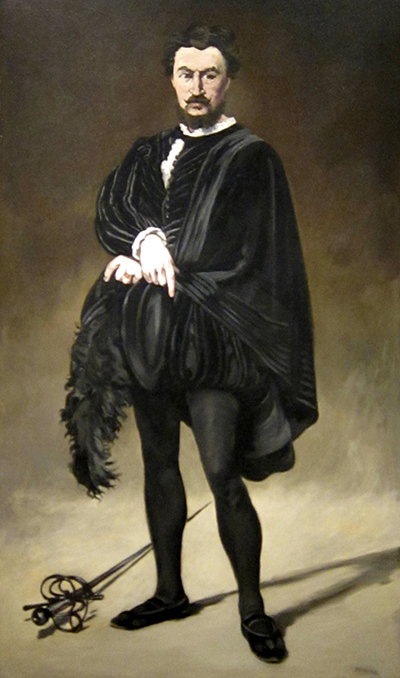Edouard Manet’s painting, The Tragic Actor, presents the French actor Philibert Rouvière, who plays the character Hamlet within the Shakespearean play.
The painting is a powerful portrait of the actor dressed in his Hamlet costume, showcasing the emotions of the character rather than himself. The painting illustrates the powerful man, starring into the distance as he embodies an array of characteristics. The muse is dressed in a classic black fencing outfit, including a fluffy suit, black leggings, and a textures cloak. While the shades of black are all the same, the different brush strokes in each piece manifest the different brush strokes used.
The man’s black texturally stripped shirt showcases a few minor ruffles at the top from his under shirt. Alongside, at the bottom of his sleeves, a minor sleeve of white is showcased. The model holds his arms crossed towards the left, in between his hands he holds his fencing hat. The viewer is able to witness that his hat is based in black feathers. Alongside at the bottom of his feet he wears tight black shoes. Next to his feet on the left lies his fencing sword, a sleek black design that matches his outfit, with an intricate detailed handle.
Based on the body language of the painting, the viewer is able to witness a prominent figure within the painting. The man stands straight with immense posture, showcasing his attire and role. The muse delicately looks to the side, acknowledging the presence of the viewer however, finding more purpose in his character. His hands are strategically placed, adding more detail to his body language, while finding an interesting way to hold the photo. The man’s facial detail is immensely painted through a realist technique, manifesting a moustache on top of a beard, and dark brown hair to accompany the look. The muse seems to be holding his eyebrows together, creating a serious expression as he looks onto the side.
As the muse is a French actor who played the role of Hamlet in the Shakespearean play, it is an interesting question to ponder Manet’s fascination in the work. As Manet is known as the forefather of modernism, his piece, The Tragic Hero, illustrates detail brush strokes similar to the technique of realism, however is a blended piece showcasing his progression into impressionism. As Manet’s work often lacked a spiritual component, or had controversial subject matter, this painting transitions away from Manet’s traditional works of woman across chaises, and studies the cultural art that was prominent at the time, and continues it’s prosperity today.




